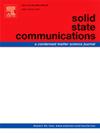共掺杂 Co 离子的 (Cd,Mn)Te 的自旋晶格弛豫
IF 2.1
4区 物理与天体物理
Q3 PHYSICS, CONDENSED MATTER
引用次数: 0
摘要
我们研究了 Co 离子的加入对 (Cd,Mn)Te 体系中自旋晶格弛豫速率的影响。在磁场中,我们通过时间分辨光谱法测量了单(Cd,Mn,Co)Te/(Cd,Mg)Te 量子阱的磁化弛豫。我们发现,即使掺入相对较少的钴,也会显著缩短锰的弛豫时间。本文章由计算机程序翻译,如有差异,请以英文原文为准。
Spin-lattice relaxation of (Cd,Mn)Te co-doped with Co ions
We study the influence of the addition of the Co ions on the spin-lattice relaxation rate in the (Cd,Mn)Te system. The magnetization relaxation is measured by time-resolved spectroscopy of single (Cd,Mn,Co)Te/(Cd,Mg)Te quantum wells in a magnetic field. We find that even a relatively small cobalt admixture significantly shortens the Mn relaxation time.
求助全文
通过发布文献求助,成功后即可免费获取论文全文。
去求助
来源期刊

Solid State Communications
物理-物理:凝聚态物理
CiteScore
3.40
自引率
4.80%
发文量
287
审稿时长
51 days
期刊介绍:
Solid State Communications is an international medium for the publication of short communications and original research articles on significant developments in condensed matter science, giving scientists immediate access to important, recently completed work. The journal publishes original experimental and theoretical research on the physical and chemical properties of solids and other condensed systems and also on their preparation. The submission of manuscripts reporting research on the basic physics of materials science and devices, as well as of state-of-the-art microstructures and nanostructures, is encouraged.
A coherent quantitative treatment emphasizing new physics is expected rather than a simple accumulation of experimental data. Consistent with these aims, the short communications should be kept concise and short, usually not longer than six printed pages. The number of figures and tables should also be kept to a minimum. Solid State Communications now also welcomes original research articles without length restrictions.
The Fast-Track section of Solid State Communications is the venue for very rapid publication of short communications on significant developments in condensed matter science. The goal is to offer the broad condensed matter community quick and immediate access to publish recently completed papers in research areas that are rapidly evolving and in which there are developments with great potential impact.
 求助内容:
求助内容: 应助结果提醒方式:
应助结果提醒方式:


